11 Best first-time Europe itineraries for 1, 2, or 3 weeks
Europe is going to be very busy in the summer of 2024 as the world is back to normal and travel demand is higher than ever. One other key factor is that most European currencies are still hovering at lower levels historically compared to the US dollar, which means that Europe will feel somewhat cheap again this year. In fact, according to our World Backpacker Index, European cities like Lisbon, Madrid, and Munich are about 30% cheaper to visit than Boston, Chicago, and New York City. In other words, flying to Europe might seem expensive, but most things will be cheaper once you get there compared to the costs of visiting a large US city.
Below you’ll find 11 of the most popular and best itineraries for a first visit to Europe. Your first visit is not really the time to be different or creative, and the famous destinations tend to be popular for a reason. In other words, it’s kind of silly to visit, say, Bulgaria, if you’ve not yet been to France or Italy. I lay out the best options along with how long to stay in each place as a general guide. I also discuss Mediterranean cruises, which can actually be an amazing way to see a lot of Europe on your first visit, especially if you don’t like going back and forth to train stations and airports every 2 or 3 days.
For a bit of fun you might be interested in the cheapest 5-star hotels in Europe, which start at US$80 per night for really nice hotels. It helps show that if you choose some of the cheaper cities, you can treat yourself to some luxury that you can’t afford in most other places.
This article was last updated in March, 2024.
There are 11 starter itineraries described in detail below
- Classic London and Paris
- England and Scotland
- Paris and Italy
- Mediterranean cruise
- France, Belgium, and Netherlands
- Paris and elsewhere in France
- Italy
- Spain
- Germany
- Switzerland
- Best of cheap eastern Europe
For each itinerary there are suggestions of other destinations that are easy to add on to the main cities.
Note: This article was most recently updated in March, 2024
Building the best itinerary for your first trip to Europe
Below there are 11 popular itineraries for one week in Europe. If you’ve only got a week then choose one of them and assume you’ll return again to conquer more of this amazing part of the world. If you’ve got more time then you can choose from some of the top add-on suggestions for each one.
Start in the most famous cities
Your first visit to Europe is no time to try to be different or edgy. I recommend that you focus on these 5 great cities before you start branching out into cheaper or more obscure places.
Keep your travel days to a minimum
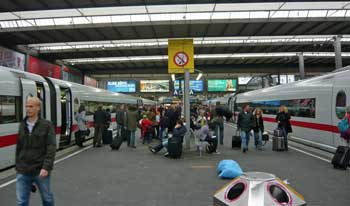
Spend 3 (or 4) nights in almost every major city
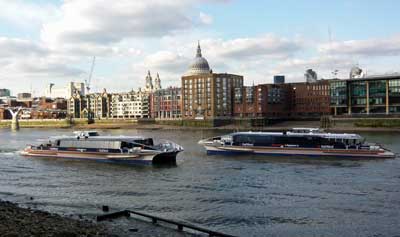
So many first-time visitors are initially planning on spending only 1 or 2 nights in major cities that I wrote a detailed explanation of why 3 nights is ideal for almost all European cities, even if you want to see as much as possible.
3 (or 4) nights will be enough for any city on your first trip
Most first-time visitors are tempted to move too quickly, but it can also be a mistake to move too slowly. It’s really amazing how much you can see in two full sightseeing days. If you spend too long in one city you’ll end up seeing things that are way down your list, while you could be in another city seeing things at the top of your list there.
Choose cities that are easy to reach from each other
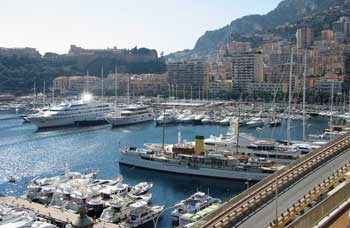
For your first trip it’s best to visit cities that are no more than a 5-hour train ride apart.
Choose cities that are connected by reasonable train rides rather than flights
To build on the point above, finding cheap flights within Europe is easy, but train travel is about a million times more enjoyable and less stressful. You’ll enjoy the train rides almost as much as the cities, so focus on places that are within 5 hours of each other by train.
Start with one of the classic itineraries below, and then add to it if you have more time
If you only have 7 days then you’ll find a list below of classic itineraries that are well-suited to a first visit to Europe. Hopefully you have more than 7 days though, and if you do you can add in one or more of the suggested add-on cities to build an itinerary that appeals most to you.
Best 1-week itineraries for the first time in Europe
Itinerary 1: Classic London and Paris
Fly into either city and take the 2-hour Eurostar train between them
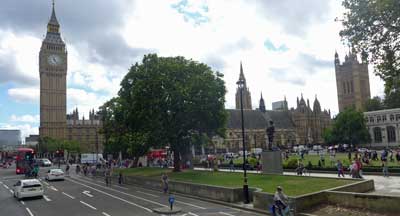
London highlights
- Big Ben and Parliament
- Westminster Abbey and St. Paul’s Cathedral
- Tower of London and Tower Bridge
- West End shows (Broadway equivalent) and classic pubs
- Buckingham Palace and Windsor Castle
Paris is actually far more beautiful than London and the food is famously much better as well. Since Paris gets so many tourists from non-French speaking countries, it’s easy to get by on just English, and the Metro system makes it fast and easy to get around. The architecture of both cities is amazing from the Tower of London, Big Ben, Westminster Abbey to the Louvre and the Eiffel Tower. These cities each pack a huge punch and they are very different from each other as well. Actually, England is arguably the best choice for your first trip to Europe.
Paris highlights
- Eiffel Tower
- Louvre Museum and Museum de Orsay
- Arc de Triomphe and other monuments
- Montmartre neighborhood and Sacré Coeur Cathedral
- Probably the world’s best affordable restaurants and wine
Best add-ons to London and Paris
- Edinburgh (2 or 3 nights, from London)
- Amsterdam (2 or 3 nights, from Paris)
- Bruges and Brussels (2 nights, from Paris)
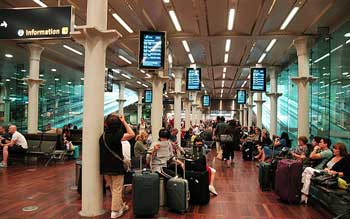
>>>Best one-week London and Paris itinerary in detail
>>>Check London hotel deals
>>>Check Paris hotel deals
Itinerary 2: England and Scotland
- London (3 or 4 nights)
- York (1 night)
- Edinburgh, Scotland (2 or 3 nights)
- Inverness, Scotland (2 or 3 nights)
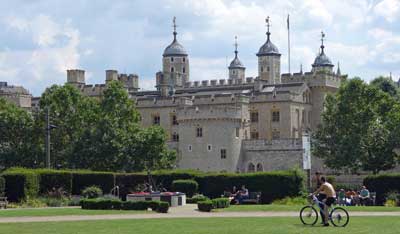
York is a small Roman city with intact city walls and one of the most famous cathedrals in Europe. Edinburgh is not only the capital of Scotland, but it’s easily the second most interesting city in all of Britain. If your time is short, skip York and spend more time in Edinburgh.
If you prefer to focus on the south of England on your first trip then the best option is to go to Bath or nearby Bristol after London. Bath is another of England’s top destinations and it’s a gorgeous city that has been a spa resort for many centuries. It’s also reasonably close to Stonehenge. You can also easily get to Cornwall in England’s southwest corner from Bath, and that’s a whole different and fascinating experience (with nicer weather than up north).
If you’ve got more than a week and want to spend more time in Scotland, especially in the summer months, the place to head to is Inverness. It’s a small town that is considered the gateway to the Scottish Highlands, but it’s an interesting and charming place on its own. You can take day-trips by bus to the highlights of the Highlands including the Isle of Skye and Loch Ness. Between you and me, it’s better to minimize time in Loch Ness or skip it altogether because it’s not one of the more photogenic parts of Scotland and the monster has always been a hoax.
Travel times between the recommended places
- London to York by train: 2 hours
- York to Edinburgh by train: 2.5 hours
- London to Edinburgh by train: 4 hours
- Edinburgh to Inverness by train: 3.5 hours
- London to Bath by train: 85 minutes
Best add-ons to England and Scotland
If you think you want to spend your whole trip in Britain you should have a look at our article on the best itineraries in England, Scotland, and Wales.
>>>Check London hotel deals
>>>Check Edinburgh hotel deals
Itinerary 3: Paris and Italy
- Paris (3 or 4 nights)
- Venice (1 night)
- Florence (2 or 3 nights)
- Rome (3 nights)
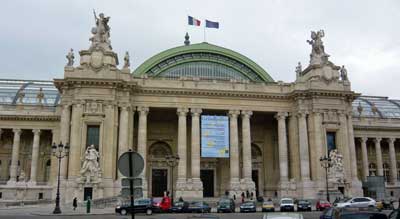
From Paris you can easily fly to Venice (or nearby Treviso) where you should try to spend about 24 hours. Venice is small enough to see in a full day, and so crowded that most people are satisfied to leave after that day. The key is to stay in the main part of the main island so you can enjoy Venice before the cruise passengers and day-trippers arrive, and also after they leave for the day. Two nights in Venice would not be wasted time, and it’s possibly the most gorgeous city in the entire world, but you can see the best of it in a bit over 24 hours.
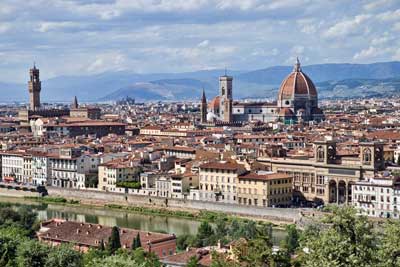
Rome also lives up to the hype and spending a day in the Vatican City will be a highlight even for non-Catholics, but it’s also a crowded and busy city so three days is usually enough for most people. Similar to Paris, Rome is an unusually beautiful city from almost any angle when you are in the historical center. You’ll walk through a stunning piazza (town square) and then turn a corner and you’ll see gorgeous buildings or public statues that are as nice as anything in the museums. Seriously, it’s worth a visit.
Paris to Venice flight: 1 hour 35 minutes
Venice to Florence by train: 1 hour 53 minutes
Florence to Rome by train: 1 hour 16 minutes
You can of course instead fly from Paris to Rome and then go north to Florence and then to Venice and fly home (or back to Paris) from there, and it would be just as enjoyable.
Best add-ons to Paris and Italy
France
- Nice/Cannes/Monaco (2 or 3 nights)
- Avignon (2 nights)
- Bourges (2 nights)
- Bordeaux (2 nights)
- Aix-en-Provence (2 nights)
- Reims (2 nights)
- Dijon/Burgundy (2 nights)
Italy
- Milan (1 or 2 nights)
- Lake Como (2 nights)
- Siena (2 nights)
- Cinque Terre (1 night)
- Naples/Sorrento/Amalfi Coast/Pompeii/Capri (3 to 5 nights)
- Sicily (3 to 4 nights)
>>>Much more information in this article about the best France and Italy itineraries
>>>Check Paris hotel deals
>>>Check Venice hotel deals
>>>Check Florence hotel deals
>>>Check Rome hotel deals
Itinerary 4: Mediterranean cruise
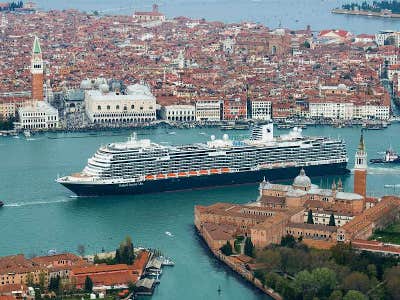
In spite of the reputation of cruises to be floating buffets, they can actually be an excellent way to visit a great number of amazing European cities in a short time. The ship typically is in port from the early morning until mid evening, often giving you the opportunity to have dinner in the city (unlike Caribbean cruises). Better still, the cruise ports are often near the center of town, so you can just walk off the ship and do sightseeing on foot or by public transportation.
Mediterranean cruises usually start at 7 nights but can go up to 3 weeks, which can provide an amazing tour of the entire region without having to pack and repack your bags more than once. They also can provide excellent value, especially compared to the price of taking trains or flights and finding new hotels in every destination.
Most popular Mediterranean departure ports
Barcelona, Spain – It’s an easy port to reach. Ships generally go from Barcelona with stops in France and then Italy.
Rome (Civitavecchia), Italy – The port isn’t very close to Rome, but it’s easy to get back and forth. Ships go west to France and Spain as well as south around the tip of Italy and then on to Croatia, Venice, and to Greece.
Venice, Italy – The cruise ships no longer dock close to the best tourist areas, but it’s easy enough to visit Venice for a day or two before boarding a ship. Ships starting in Venice go south and then head west and to Rome and then to France, or they go south to Croatia and then head east to Greece.
Athens, Greece – The cruise port of Piraeus is just south of Athens and easy to reach. Ships from Athens usually head west towards Croatia, Italy, France, and Spain, but there are also ships that visit Greek islands and Turkey.
>>>Check for deals on Mediterranean cruises
Alternative to consider: a river cruise
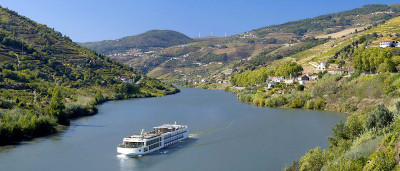
Amsterdam, Budapest, and Prague are some of the most popular river cruise ports, but there are dozens of others including many smaller towns in France where few other tourists will be when you stroll off the ship. There is little or no entertainment on the river cruise ships, but passengers don’t miss it because the entire day and into the evening is spent just steps from local cultural offerings and restaurants.
>>>Check for Europe and river cruise deals
Itinerary 5: France, Belgium, and Netherlands
Paris to Brussels: 1 hour 22 minutes
Brussels to Bruge: 58 minutes
Bruges to Amsterdam: 2 hours 45 minutes
Amsterdam to Paris: 3 hours 17 minutes
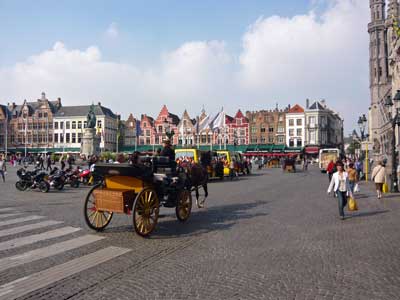
Spending 4 nights in Paris and 3 nights in Amsterdam would be a great trip, but if you want to see something else you’ve got a couple options in between. My advice is to spend an afternoon looking around the Grand Place (main square) in Brussels and then hop a 58-minute train ride to Bruges for a night or two. Brussels isn’t a great tourist city, but Bruges really is so it’s a better option for most people. Whatever you choose out of this group, you can be back in Paris on another high-speed train for your flight home.
Best add-ons to France, Belgium, and Netherlands
- Luxembourg City (1 or 2 nights)
- Cologne, Germany (1 or 2 nights)
- London (3 or 4 nights)
- Interlaken, Switzerland (2 or 3 nights)
>>>Check Paris hotel deals
>>>Check Bruges hotel deals
>>>Check Amsterdam hotel deals
Itinerary 6: Paris and elsewhere in France
- Paris (3 or 4 nights)
And a choice of:
- Nice/Cannes/Monaco (2 or 3 nights)
- Avignon (2 nights)
- Bourges (2 nights)
- Bordeaux (2 nights)
- Aix-en-Provence (2 nights)
- Reims (2 nights)
- Dijon/Burgundy (2 nights)
- Normandy (2 nights)
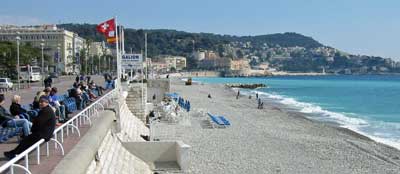
While Nice is a wonderful tourist city for a look at the French Riviera, the other larger cities of Lyon and Marseilles are probably better saved for a future trip because they are light on key sights compared to many smaller towns. Wine lovers can rent a car or take trains into Bordeaux or Burgundy. Since you can get between most of these towns by train in 2 hours or less, spending only 2 nights in each one is a reasonable option if you want to see a lot in a short time.
Normandy is an interesting choice and easy to reach in only about two hours by train from Paris. Some visitors like to see the famous WWII beaches and memorials, while others (especially in summer) like to check out one or more of the beach-resort towns. Deauville is one of the more famous of those, and it’s also famous for its horse race track and as one of the epicenters of the industry in Europe.
Best add-ons to Paris and elsewhere
- More France, of course
- London (3 or 4 nights)
- Interlaken, Switzerland (2 or 3 nights)
- Amsterdam (2 or 3 nights)
>>>Check Paris hotel deals
>>>Check Nice hotel deals
Itinerary 7: Italy
Rome to Florence: 1 hour 16 minutes
Florence to Venice: 1 hour 53 minutes
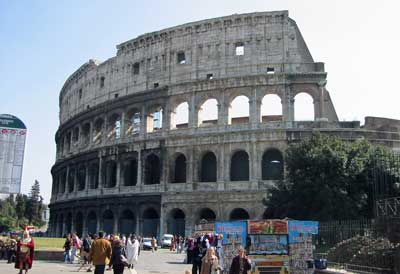
Venice is small enough that you can see the main sights in about 24 hours, and it’s so insanely crowded that many people tire of it after about a day as well. It’s better to pay more for a hotel to be on the main island and visit quickly than to save money with a hotel on the mainland where you’ll be in crowds going back and forth as well. Florence is the most relaxing of the 3, and also a great base for side trips to Pisa, Siena, and Cinque Terre, just to name a few.
Going to Italy? Here are the best first-time Italy itineraries for 3 days to 2 weeks (in much greater detail)
Best add-ons to Italy
- Milan (1 or 2 nights)
- Lake Como (2 nights)
- Siena (2 nights)
- Cinque Terre (1 night)
- Naples/Sorrento/Amalfi Coast/Pompeii/Capri (3 to 5 nights)
- Sicily (3 to 4 nights)
>>>Check Rome hotel deals
>>>Check Florence hotel deals
>>>Check Venice hotel deals
Itinerary 8: Spain
Madrid to Barcelona: 2 hours 30 minutes
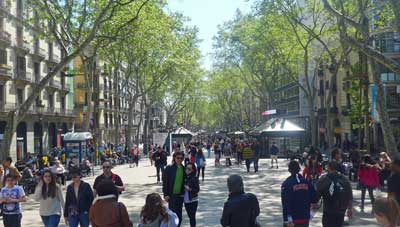
A huge part of Spain’s tourism industry is built around its southern beaches and islands such as Ibiza, Mallorca, and Tenerife (in the Canary Islands). For most people it’s best to ignore those places on your first trip because none of the beaches are special enough to spend days on them compared to the culture of the cities.
Best add-ons to Spain
By popular demand, I’ve added a full article on where to go in Spain with itineraries from 7 to 10 days up to two weeks.
>>>Check Madrid hotel deals
>>>Check Barcelona hotel deals
>>>Check Lisbon hotel deals
Itinerary 9: Germany
Berlin to Munich: 6 hours 2 minutes
Munich to Rothenburg ob der Tauber: 2 hours 56 minutes
Munich to Füssen: 2 hours 4 minutes
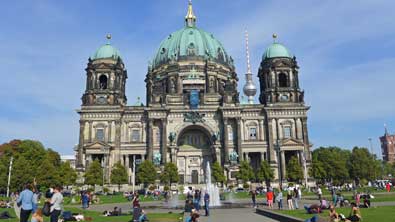
Those two cities are the keys to a Germany visit, and after that you’ve got a wide variety of choices. I cover most of the popular choices in my article on where to go in Germany, which covers several smaller towns that are major highlights.
Best add-ons to Germany
- Cologne (1 or 2 nights)
- Hamburg (2 or 3 nights)
- Amsterdam (3 nights)
- Prague (3 nights)
- Salzburg (2 or 3 nights)
- Vienna (3 nights)
- Interlaken, Switzerland (3 nights)
- Lucerne, Switzerland (2 or 3 nights)
>>>Check Berlin hotel deals
>>>Check Munich hotel deals
Itinerary 10: Switzerland
- Interlaken (3 nights)
- Bern (1 night)
- Lucerne (3 nights)
Zurich Airport to Interlaken: 2 hours 10 minutes
Interlaken to Bern: 53 minutes
Bern to Lucerne: 1 hour 50 minutes
Lucerne to Zurich Airport: 1 hour 3 minutes
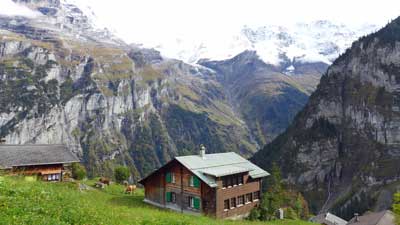
Interlaken is the best hub for the most dramatic Alps views and experiences. The one-hour cable car ride up to the Schilthorn observation deck is something you’ll never forget, and the only thing that might be more dramatic is the train ride up to the Jungfraujoch station, which is the highest in Europe. Lucerne is almost as beautiful with a scenic lake at its heart and also great mountaintop views nearby. If you do want to see a Swiss city then the capital of Bern is the most interesting and photogenic on a short visit. Read more about where to go in Switzerland for even more ideas.
Best add-ons to Switzerland
>>>Check Interlaken hotel deals
>>>Check Lucerne hotel deals
Itinerary 11: Eastern Europe’s best cheap cities
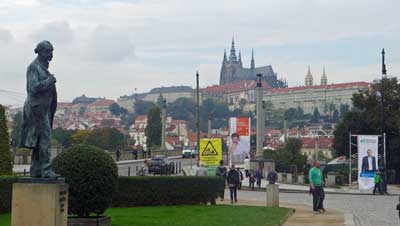
Each of these cities is beautiful and historic, but English is less widely spoken so they can also be quite a bit more challenging for a first-time visitor. Another difficulty is that the trains between them are still quite slow compared to the high-speed rail in the West, so it takes most of a day from one to another, and a bus is often a better choice. I cover this best cheap Europe itinerary more fully in the linked article.
Prague to Budapest: 6 hours 41 minutes
Budapest to Krakow: 9 hours 54 minutes (flying might be better)
Best add-ons to cheap Eastern Europe
- Cesky Krumlov, Czechia (2 nights)
- Ljubljana, Slovenia (2 or 3 nights)
- Split, Croatia (3 nights)
- Belgrade, Serbia (2 or 3 nights)
- Sarajevo, Bosnia and Herzegovina (2 or 3 nights)
- Sofia, Bulgaria (2 or 3 nights)
>>>Check Prague hotel deals
>>>Check Budapest hotel deals
>>>Check Krakow hotel deals


Hello Roger,
I’m traveling with my middle son to UK to pick up my eldest son the grandbaby for a European getaway. I have about 18 days total from December 18 to January 5 and would LOVE to see as much as possible!!! Aside from wanting to see it all 😉 AND keeping it cheap, we must make a stop in Germany (Cologne)for about 3-4 days to see close relatives.
Having to pay almost all the travel bills for the entire family, what is your recommendations? Is there a possibility to see UK, Paris, Amsterdam, Coliseum, Germany and back to UK in 18 days?
Your recommendations are so informative.
Thanks in advance.
Shoreh
Shoreh,
First off, you might be interested in my recent list of my Europe recommendations for December. If you have 14 days, not counting the days you’ll spend in Cologne, you’ll have time to visit 5 cities or so. If you tried to go faster than that you’d end up spending half your time on trains, and also it costs money each time you go to another city. I’d spend 3 or maybe 4 days in London, and then take the Eurostar train to Paris for 3 days. Then you can take a train to Amsterdam in a bit over 3 hours, or you could stop in Cologne on the way and then go to Amsterdam after that. If you wanted to visit Rome and perhaps also Florence and Venice, the best thing to do would be to fly from Amsterdam or Cologne, and then take the train while in Italy before flying back to London. You could see Rome in 3 days and then you’d still have time for Florence or Venice, or maybe both. That would be my best recommendation for seeing the most top cities that time of year. Let me know if you have any questions. -Roger
Hey,
I was thinking of traveling to Europe for the first time during the summer for a month. I’ll be in London for 10 days to visit my family and friends. Where would you recommend me to go for the other 20 days?
Thank you
Zoey,
If you have 20 days of a first visit to Europe after your time in London I would definitely go next to Paris for 3 or 4 days. You can take the Eurostar train so it’s the easiest place to go next. After that you could take a 3-hour train ride up to Amsterdam for 3 more days. That leaves you with about 13 days left.
From Amsterdam I would fly to Italy for at least a week, if not the whole 13 days. You could fly into Rome and then go north to Florence and Venice, or fly into Venice and go south from there. If you did Italy in 7 days, which is about the fastest you’d want to go, you would even have time to fly to Madrid and then take a train to Barcelona after 3 days, or the other way around. Or again, you could stay in Italy the rest of the time. Those are my top suggestions for the best possible first visit. Let me know if you have any questions. -Roger
Roger hello,
Its Noa again, we have decided to travel 21-30 days.
during september-october, I would like to get your reccomendation for a trip in east/west europe( like you said east europe is less expencive, but is it relevante for 21-30 days?).
like I said before we prefer to visit more than 3 countries.
In west europe we want to visit italy, france, germany, netherlands(if its possible to visit all of them)
we have no preferance for east of europe.
Im sorry,I know its very general but we hope for your wise guidness.
Thanks for your comment Roger, much appreciated. Cheers – Richie.
Hi Roger, I am planning a 20-day itinerary for Western Europe in the beginning of June next year. I took your advice and the itinerary currently looks like the one below. 7 cities, 6 countries. I am thinking if it would be better to have an extra night in Munich instead of Prague. Let me know what you think?
Day 1: Arrive in London at 7:05 AM, sleep in London”
Day 2: London, sleep in London
Day 3: London, sleep in London
Day 4: to Paris, sleep in Paris
Day 5: Paris, sleep in Paris
Day 6: Paris, sleep in Paris
Day 7: to Amsterdam, sleep in Amsterdam
Day 8: Amsterdam, sleep in Armsterdam
Day 9: Amsterdam, sleep in Armsterdam
Day 10: to Berlin, sleep in Berlin
Day 11: Berlin, sleep in Berlin
Day 12: Berlin, sleep in Berlin
Day 13: to Prague, sleep in Prague
Day 14: Prague, sleep in Prague
Day 15: Prague, sleep in Prague
Day 16: to Vienna, sleep in Vienna
Day 17: Vienna, sleep in Vienna
Day 18: to Munich, sleep in Munich
Day 19: Munich, sleep in Munich
Day 20: fly home, leave Munich at 5:05 PM
Cheers,
Richie
Richie,
I think this itinerary looks just about perfect. My family is from Germany and I’ve spent a lot of time all over the country, but still I think Prague is quite a bit more interesting than Munich. And I think Berlin is also much more interesting than Munich, so I’d leave it just like this. Munich has an impressive Old Town area, but most of the city is quite modern. There’s the BMW attraction and of course Oktoberfest, plus many great beer gardens and beer halls, but aside from those things it’s mostly just an impressive place to hang out in or live.
And Vienna has a lot going for it, but I’d do just two nights there as well if you don’t have more to spare. The famous buildings around the ring road are very impressive and so are the palaces and such. On the other hand, it’s really dead at night for the most part, so two days and nights should be enough to see the highlights. Let me know if you have any other questions. -Roger
Hi Roger,
Thank you for all your amazing itineraries, especially this concise one. My partner and I have only been to Italy (for nearly a month) and would like to plan a multi-country journey this time for 23 nights or less around middle of March 2018. Our current plan:
– Fly into Paris, stay 4 nights (incl. 1 day trip to Chartres)
– Eurail train to Bruges, 1 night
– Amsterdam, 2 nights
– Berlin, 2 nights
– Dresden, 1 night
– Prague, 3 nights
– Munich, 3 nights
– Bern then transfer Interlaken, 3 nights
– Back to Bern, 2 nights, before flight back to Australia.
Does the plan seem feasible? Should I change smaller towns or extend dates? Also, would Eurail benefit over Eurostar and flights for our case? Thank you so much.
Geoff
Geoff,
It’s my pleasure to try to help. My strong preference is to stay 3 nights in almost any city I visit, except for 1 or 2 nights in a few of the smaller towns. The main reason is that it gives you two full sightseeing days, which is enough to see all of the best and most important sights in each city. Paris and London are large enough that 4 nights is even better.
Bruges is small enough that one night is okay, although two nights is better. And Amsterdam is compact enough that you can at least see the 3 or 4 most famous things in 2 nights (one full sightseeing day), but I’d recommend 3 nights there as well. Berlin is huge and it’s extremely cool and interesting, but if you don’t have too many things on your list for Berlin then 2 nights could work. I’d skip Dresden altogether. The historic center looks nice because it was rebuilt to look like it did before WWII, but I’d MUCH rather have a third day in Berlin.
Three nights in Prague is perfect, and Munich in 3 is good as well. Switzerland is expensive, even compared to the other places on your list, but it’s got by far the best scenery. MY recommendation would be the three nights in Interlaken or perhaps 2 nights there and two nights in Lucerne. I’m not sure if you’ve seen it yet, but you may find my where to go in Switzerland article to be interesting. Bern is the best looking city and it’s interesting for a day or so, but it’s small and the scenery is much better. In other words, I’d probably recommend spending a few hours in Bern or maybe 1 night, but probably not 2.
The Eurostar is the name of the train company that runs between London and Paris or Brussels. Eurail Passes are sold by certain companies and they allow you to ride most trains in Europe for free or only a small seat reservation fee of €5 or so. And Eurail Passes are kind of expensive compared to advanced train tickets, so they are mainly helpful to people on longer trips who want to make plans as they go. For a trip like yours where you have a pretty tight itinerary you can save much more money by buying individual train tickets at least a month or two in advance. As long as you buy early you will probably average €50 to €60 for your longer rides, which is much cheaper than the daily fare on a Eurail Pass that you might buy.
For your itinerary the trains are the best way to go. In some cases a flight might be around the same price, or perhaps even slightly cheaper, but the train is a million times more comfortable and enjoyable, and for those cities on your list it should be faster as well. Let me know if you have any other questions. -Roger
roger hello.
first thank you for a very informative and interesting article.
i would like to get your reccomendations about a 16 days trip to europe.
Im 20 years old from israel and Im planing to go on a trip with a friend during october.
we would like to see nice natural views and beaches in addition to urban views.
we want to visit at least 4 countreis, is it possible?What is the best itinerary that we can follow to make the most out of travel?
again, thank in advance.
Noa,
In general my recommendation is to spend 3 nights in almost every city or place you visit because shorter stays mean you are spending too much time going between places, and longer stays mean you don’t see as much and you end up doing some second and third tier attractions. So with 16 days I’d plan on 5 stops or maybe 6 stops if one of them is a small town with only a few things to see and do.
If you want to spend time on a beach you will obviously be limited to southern countries in October. Here is my recent list of the best Europe destinations in October, which includes some beach areas. If I were you I’d start by picking at least one or two of the cities on that list and then seeing where else you can go that is near enough to reach in 6 or fewer hours by train.
I’m not sure why you want to visit at least 4 countries rather than at least 4 or 5 great places that may be in only 2 countries. But if for some reason you want to rack up some countries for your list you could go to Croatia, Bosnia, Slovenia, and Italy as one example. The best beaches are mostly in Spain, and if you visit Spain you can also visit Portugal or France, but it won’t be easy to do all 3 or reach another country. Some Greek islands also have nice beaches and October is the last month where you can get nice enough weather, although earlier in the month is better, of course.
You could also do Italy and France, which both have plenty to keep you busy for the whole 16 days. As far as natural views are concerned, I think the most impressive are in Switzerland and elsewhere in the Alps, but also the Plitvice Falls National Park in Croatia. I hope this at least gives you a bit more to think about. I’m happy to help with more suggestions and details once you narrow down at least one or two main cities or places you want to include. -Roger
Roger,
You are extremely informative and that’s why I’m asking you for advice. I plan on going to Europe for the 1st time in October. I feel like I might not be going during the most ideal season since I love the warm weather and beaches. I am from New York. I would like to visit at least 3 major cities or countries within 10 days with 2 friends. I would definitely like to visit Spain, what are your thoughts? It will be very much appreciated. Thanks
Steve,
Thank you for the kind words. Interestingly enough, if I had to pick one month to visit Europe it would be October, with May being a close second. The weather is still warm enough to be pleasant for sightseeing, and the crowds are much smaller and hotel prices are down as well. Most of Europe can be like NYC in summer where if you get unlucky it’s very hot and humid, except far fewer places in Europe have air conditioning. And in Spain you are pretty much guaranteed of a sizzling summer almost every day. September might be better for you, but we will work on October.
I think your plan of 3 great cities in 10 days is perfect, and you might even have time for a little day trip or two. Since you want to visit Spain I think your key city should be Barcelona since it’s also got beaches and it should at least be warm enough for a pleasant stroll, if not for sunbathing. Then I’d pick 2 of the following 3 cities to add to Barcelona: Madrid, Paris, or London. As I write so often, Madrid and Barcelona are very different from each other so visiting both of them makes sense. However, if you were asking me this as a friend of mine I’d recommend Paris and London. You could fly into Barcelona and spend 3 days there before taking a 6.5-hour train to Paris. You could fly just a bit quicker, but the train is far more interesting and pleasant. Then you can take the Eurostar train from Paris to London in a bit over 2 hours. Then you can fly home from London, or back to Barcelona for your flight home if that’s cheaper. Or you could first fly into London and then immediately fly to Barcelona to start the trip as described.
For a first trip to Europe I really think Paris is the most magical place, and it’s easy to reach many other worthwhile places from there. London is also a huge favorite because so many people are so familiar with the main sights there and all of that. I’m happy to help with more advice if you need it. Let me know if you have any other questions. -Roger
We will be attending a wedding in Amsterdam and will have at least 9 days. I am looking for a best possible way to explore Paris, London, and others that would include visit to Our Lady of Lourdes (France) and Our Lady of Fatima in Portugal. There will be 8 of us travelling from Canada. If we will be in Amsterdam on Thursday and the wedding on Saturday, I will have Friday and Sunday to the following Saturday (7 days). What is the best itinerary that we can follow to make the most out of travel. Thank you.
Mariewin,
This sounds like a really interesting trip, and I’m not used to planning pilgrimages. First off, all of those four destinations other than Amsterdam are far enough from Amsterdam that there’s really no way you could visit them on that first Friday without literally spending almost the entire time in transit. Also, Amsterdam is one of the world’s most beautiful and interesting cities so I have a feeling you’ll be quite entertained there.
Now, if we are looking at Sunday through the next Saturday, that’s just 6 nights. From Amsterdam you can take a train to Paris in just over 3 hours, or you could take a train to London (changing in Brussels to board the Eurostar) in about 5 hours. If you go to Paris first you can then take the Eurostar train from there to London in a bit over 2 hours. The train from Paris to Lourdes takes just under 5 hours. You could fly instead, but it wouldn’t really be any faster when you include the airport transportation, and it would be far less enjoyable compared to the train.
Fatima is 90 minutes by bus from Lisbon, and it would take far to long to reach Lisbon by ground, so you’d have to fly. Unfortunately, it would be almost impossible to visit all of these places with only 6 nights unless your only goal was to see them quickly and move on right away. The Catholic sights are quite remote, so if those are your top priority the best way to do it would be to take a train from Amsterdam to Paris. Then take a train to Lourdes for as long as you like. From there you could fly from the small nearby airport or take a train to the larger Toulouse Airport for a flight to Lisbon to visit Fatima.
If you are willing to skip those two distant places on this trip you could take a train from Amsterdam to Paris and spend 3 wonderful days there and then take the Eurostar from Paris to London for your final 3 days. Needless to say, there are important cathedrals in both of those cities as well. I hope this helps. Let me know if you have any other questions. -Roger
Thanks Roger.
That was my concern regarding the overnight trains after reading your link. Our logic was that If we ended up staying in hotels and flying out the following morning – it would cut into valuable time which is scarce for us. Maybe I’ll call my doctor up and ask for a few extra Ambien for that part of the trip lol.
Yeah I think we might end up doing the eurostar from london to brussles then amsterdam. Unfortunate the direct one isn’t happening until early next year!
This might be a stretch but regarding Prague, Krakow, Budapest, and Vienna – would you be able to recommend a specific area within those cities that would be more fun for single 30 year olds? I haven’t done the research on hotels yet but thought I’d ask and see if you could simplify it even more for me.
Thanks again for the solid advice.
Poursha
Poursha,
For Prague it’s best to stay as close to the city center on the east side of the river as possible. In Krakow the Jewish Quarter, which is a bit west of the center, has the best nightlife. In Budapest you get much better value by staying east of the river, and the nightlife is great even in a mile or so away. Look for what they call “ruin pubs” in Budapest. Vienna is kind of stodgy, but generally if you stay in the main ring you are best off. Have a great trip. -Roger